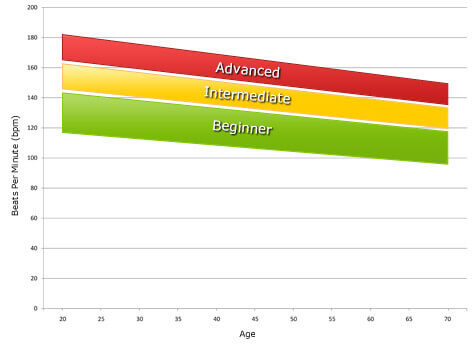Tools & Calculators
Find Your Target Heart Rate Range
Your target heart rate range (in beats per minute) is:
Cardiorespiratory fitness is the ability of the heart, lungs, and circulatory system to supply oxygen and nutrients to the working muscles. It involves the ability to persist in activities, such as elliptical training, walking, jogging, and cycling. Improved cardiorespiratory endurance is associated with increased brain and physical health and a reduced risk of chronic disease, such as obesity, heart disease, type 2 diabetes, high blood pressure, and stroke.
To experience the health benefits of cardiorespiratory training, any movement that gets your heart beating faster counts. While an eventual goal may be to complete at least 150 minutes of moderate intensity aerobic activity each week, it is important to remember that bouts of activity of any length contribute to the health benefits associated with the total accumulated volume. Once you can complete bouts of moderate intensity activity for at least 20 continuous minutes you may be ready to progress your workouts.
There are many methods for determining if you are working at an appropriate intensity to maximize the health benefits of an activity including the talk test, RPE, and heart rate. If using the talk test to gauge your exercise intensity a general rule of thumb is that if you can talk, but not sing, during the activity then you are working at an appropriate level. You can also use the table below to rate how hard you feel that you are working. Initially, aim for a score of 3 to 4 or 12 to 13. Measuring heart rate is another common way to monitor your exercise intensity and is covered below.
Measuring Heart Rate
The measurement of heart rate, or pulse, is represented in beats per minute (bpm). To assess heart rate, place your fingertips on either the radial or carotid pulse site. If you choose to take your pulse at the carotid side, avoid putting heavy pressure on the carotid arteries because they contain receptors that sense increases in pressure and respond by slowing the heart rate.
To determine the number of beats per minute, take the pulse rate, counting the first pulse beat as zero, for 10 seconds and then multiply by six.
Target Heart Rate
The rate at which your heart beats during exercise can be used to assess how hard you are working. When performing light to moderate exercise, your heart rate increases as your work rate increases. This ensures that blood gets to the muscles so that they can get the oxygen and nutrients they need to continue working.
Being able to measure your heart rate allows you to determine aerobic exercise intensity by taking your pulse during the workout and comparing it to your target heart rate. A common method to determine your target heart rate is based on a percentage of your estimated maximum heart rate. Input your age in the prompt below and the calculator will produce a range in which to keep your heart rate during aerobic exercise.
Now that you know your target heart rate range, you can check your pulse at regular intervals (every 5 to 10 minutes) during the workout session and compare your exercise heart rate to your target heart rate. If your exercise heart rate is below the target range, increase your pace or effort slightly to achieve the proper intensity. If your exercise heart rate is above the target range, decrease your pace or effort slightly to remain with the range.
While this method is widely used in the fitness industry, it can be inaccurate for many people. Therefore, gauging intensity using a percentage of predicted maximum heart rate should be used along with another method to ensure appropriate exercise intensity. For example, using heart rate and perceived exertion can be used together to ensure alignment of heart rate and feelings of effort. Perceived exertion is a technical description of simply paying attention to how you feel during a workout.
Heart Rate Training Zones
Another way to evaluate your aerobic exercise intensity is to compare how you feel to an established guide, such as a heart rate training zone. For our purposes and for new exercisers, training target zones can be thought of as a traffic light where the green, yellow, and red lights correspond to the intensity of exercise. That is, the green training zone represents an appropriate level of intensity (moderate exercise) that indicates "continue," like a green traffic light. The yellow training zone indicates an intensity that is vigorous, and if performed for too long could result in fatigue. When training in the yellow zone (vigorous exercise), an exerciser should slow down or proceed with caution if the intensity feels too high, similar to the rules for a yellow traffic light. Lastly, exercising at a near maximal or maximal intensity reflects training in the red zone, which corresponds to a red traffic light, which means stop.
Exercise in the red zone may be harmful to beginners or people with health conditions and should be reserved for those who are experienced exercisers or under the care of a trained health professional.

Share:
Get in the Know
Stay connected with us to get the latest health and fitness news, innovative workouts, healthy recipes and wellness tips.



